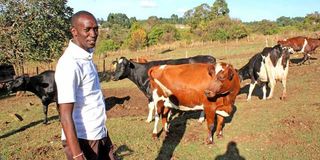Innovative silos cut post-harvest silos

Henry Rop, the farm manager at Open Arms Rescue Centre in Mlango on the Nandi-Uasin Gishu counties border. The centre has 23 dairy cows.
Some kilometres off the Eldoret-Kapsabet road in Mlango is Open Arms Rescue Centre. Mlango town lies on the Nandi-Uasin Gishu counties border.
The farm at the rescue centre has vegetables, grains and livestock. Of its 52 acres, the institution utilises four for agriculture.
There is mixed farming, which ensures a continuous supply of food and helps reduce reliance on donations.
The children’s home is run by Standbyme Open Arms, a United Kingdom-based organisation. The charity operates in eight countries, including Ethiopia, India, Nepal and Romania.
Open Arms Village started in 2006. It provides shelter and other basic needs to children aged zero to eight.
It also supports children from poor backgrounds. The children are given education and training in farming and table banking.
Exotic and indigenous vegetables are grown on the farm.
These include kunde, Nightshade (managu), spider plant (sagaa), kales, spinach and cabbage.
“There is a huge demand for vegetables locally which we are not able to satisfy. A bunch of vegetables goes for Sh50 to Sh100,” Henry Rop, the farm manager at the rescue centre, told the Seeds of Gold team.
Irrigation
To ensure a steady supply of vegetables, grains and other crops, the centre has embraced irrigation.
Water is sourced from River Kipkaren, about 500 metres away. Electric power pumps water from the river to a tank on a nearby hill.
Gravity then takes over, with the water flowing to another tank in the farm. Sprinkler is the preferred irrigation method at Open Arms Rescue Centre.
The produce is consumed at the institution while the surplus is sold to traders from Mosoriot, Kapseret, Siwa, Langas, Eldoret and other towns. The farm at the rescue centre has 23 dairy cows, with nine lactating.
The animals produce 140 litres every day. The milk is sold to the neighbourhood for Sh60 to Sh70.
The farm also has poultry, Dorper sheep and dairy goats.
At its peak, Open Arms Rescue Centre had 900 chickens but reduced the number to about 300 due to what the management says was the high cost of feeds and other inputs.
It is not all rosy at the rescue centre. The farm faces many challenges, including pests, diseases and the high cost of livestock feeds and drugs.
Innovative silos help reduce post-harvest losses and ensure the grains are safe for consumption.
Silos come in different sizes and have an inlet and outlet.
Pest control
Rop says the innovation helps employees at the farm control pests. “We don’t use any pesticide or chemical. For the last two years, we have been using these silos and have not suffered any post-harvest losses,” the farm manager says.
Once the grain has been harvested, it is dried. Rop says the workers ensure the grain attains a 12 per cent moisture content.
Thereafter, the grain is poured into a silo. When full, the silo is sealed. A candle is then lit and placed inside until it goes off.
“That expels any oxygen still in the silo. Oxygen usually supports the survival of pests. After 14 days, the grains are ready for use,” the farm manager says.
One store at the rescue centre has 15 silos, which are also used to keep beans, green grams and other cereals and legumes.
The centre also makes and sells the silos to farmers and other organisations for Sh3,000 to Sh38,400.
“We get many orders during the harvest season from October to January. The centre makes 20 to 30 silos in a month,” Rop says.
Open Arms Centre director Lydia Mudheia says the farm has helped save on costs and train the children and surrounding community to boost food security.
She says farmers from the nearby and far-flung villages are trained on modern agriculture practices for free.
“This farm gives us fresh vegetables, milk and eggs. I encourage other rescue centres to have such farms,” she says.
Uasin Gishu County Agriculture director Reuben Seroney says farmers lose up to 25 per cent of their produce after harvesting as the grains are exposed to rain and moisture. He says the devolved government is putting up stores and silos in different parts of the county.
“We are constantly organising farmers in groups to enable them to manage post-harvest losses,” he says.
Seroney adds that the county government has been encouraging farmers to work with agriculture extension officers in wards in an effort to reduce post-harvest losses.
“With climate change, the weather has become unpredictable. We can no longer tell when the rains will fall. We encourage farmers to work with the Meteorological Department as that will inform them when to plant, harvest, shell, sell and store their produce,” he says.





